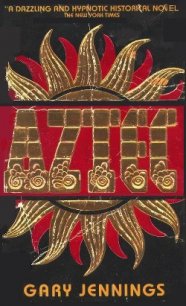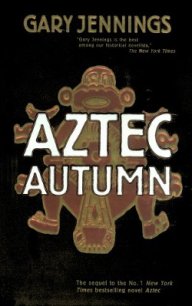Aztec Blood - Jennings Gary (книги онлайн бесплатно серия .txt) 📗
"Isn't that what the last printer was doing?"
"He was a drunk and a fool. He was supposed to send a case of religious printing to a convent in Puebla and a case of banned books to his partner in crime. Unfortunately, he had drunk enough wine that night to make him cross-eyed when he marked the boxes. So you can imagine what the nuns received..."
I wondered what he thought when the familiars of the Inquisition showed him the box that was supposed to contain pious tomes and instead had libros written by the devil himself. Had the printer been a lepero, he would have shown shock at the discovery and been aghast that Lucifer could turn prayers into lust.
"I still don't understand why we need the printer's business," I said.
"How did you plan to sell the books? Spread a blanket under the arcade in the plaza and lay the books out? The widow has a list of customers that the printer supplied. And customers know how to contact the printer's establishment."
While Mateo occupied himself in making contact with the printer's former customers, I found myself fascinated with the mechanism called a printer's press. I was intrigued both with the history of printing and how a press was used to put words on paper.
Without letting Don Julio know about my motives, I steered him into a conversation about the history of printing. He told me that words—and picture words like the Egyptians and Aztecs used—were originally etched in stone or marked on leather with dye. While the Aztecs and the Egyptians used bark and papyrus to make paper, better methods were known to the Chinese and learned by the Arabs from Chinese prisoners taken at the Battle of Talas in 751. The Arabs spread the knowledge of paper making across their Islamic world, and Moors carried it to Spain where the art was highly perfected. The Chinese were also the ones who perfected the art of printing by the use of moveable type.
The peoples of China have given the world many wonders, the don told me. The society was so amazing that when Marco Polo came back from their land and told his fellow Europeans of the things he had seen, they called him a liar.
"But the Chinese," Don Julio said, "like the Aztecs, were prisoners of their own writing techniques. Aztec picture writing and the thousands of marks used by the people of China does not lend itself easily to printing. It was a German named Gutenberg who used the Chinese techniques of moveable type and paper to print large numbers of books. He was doing this forty or fifty years before Columbus discovered the New World."
While the Chinese had originally used hardened-baked clay for type, the type in use for printing today was a mixture of lead, tin, and antimony, an alchemists combination of metals soft enough to be easily turned molten and molded into letters but hard enough to give thousands of imprints on paper before wearing out. The pieces of type are formed by pouring the molten lead into molds made from a special mixture of hard iron.
"Another great step in printing was the use of a codex rather than a roll," he said. Rolls of paper were difficult to handle and print on. When clever printers cut the rolls into sheets to be attached on one side like books are now done, the sheets could be run through a printing press.
"Book selling and making are not considered honorable trades," Don Julio said. He surprised me by informing me that he had once owned a print shop. "I used it to publish my scientific findings on the geography of New Spain and the mining industry. You will find the works in my library. I sold the press after it was discovered that my pressman was coming in at night to print libros deshonestos, showing people having sex with animals. He was arrested by the Inquisition and fortunately he had done the printing at a time when I had returned to Spain and hence could not involve me. I sold the press immediately for a pittance, happy that I had not been burned at the stake, with the scandalous sheets used to get the fire going."
He told me the viceroy called printing and book selling, which were customarily done out of the same shop, a vulgar profession.
And the Inquisition took special interest in those who printed books and other documents. Bishops often referred to it as a "black art" and the reference was not just to the color of ink. The Church frowned on reading other than that necessary for religious training and good moral character, which of course, is why the libros de caballerias like Amadis of Gaul were banned in New Spain.
The Inquisition paid particular attention to the printing business in New Spain and decreed that no book be printed or sold without permission of the Church. Since the king had sold away New World printing rights to Seville publishers, the range of books one could have published was few indeed even before the Inquisition became involved. One could even get in trouble for printing religious works, for Christian doctrine to appear in any language but Latin was considered heresy. Even a translation of the Bible into Nahuatl was seized. The Church wanted to ensure that it controlled what the indio read, just as it insisted upon not having the Bible translated into Spanish.
Permission to publish had to be obtained from the Inquisition, and the name of the bishop giving permission was to be noted on the front page of the book along with other information that had come to be included in the colophon—the title itself, the name of the author, the name of the publisher, and sometimes a sentence or two praising God.
Don Julio had told me that this title page originated from the days when medieval scribes placed their names, the date they finished their labors, and quite often a notation about the book or a short prayer at the end. He had several medieval works in his library, and he showed me the inscriptions at the end of the codices.
His library also contained the first book that was printed in the New World. Referred to as a Short Doctrine on Christianity, the Breve y mas compendiosa doctrina Christiana en lengua mexicana y castellana was published in 1539 by Juan Pablos, a printer from Italy, for Juan de Zumarraga, the first bishop of the City of Mexico. "The first book we know of," the don said, "but there are always rogues who would print their mother's sexual confessions and sell them for a few pesos."
The don's comments about book rogues only earning a "few pesos" proved to be prophetic. Mateo and I soon learned that after we paid off the book publisher and go-between in Seville, customs and Inquisition officials on two continents, the ravenous Recontoneria in the colony, and the grieving widow who sold us the right to be criminals in her husband's shoes, we had almost nothing left for ourselves.
This put Mateo into a black mood and sent him off to drink and lust and fight. The failure of my first large criminal scheme, and with it my dream of being a hidalgo who could at least stand in the same room with Elena without being horsewhipped, had left me pensive. My own dark mood was aggravated every time I thought about what had happened with the woman Maria. I refused to even think of her as my mother. As the fray said, I have no mother. I carried that mood with me to the print shop, where it had become my habit to tinker.
For some time I examined and experimented with the printing press in the shop we had acquired. Books had made me something more than a social outcast, at least in the minds of Fray Antonio, Mateo, and the don. Because books carried so much power, so many thoughts and ideas and knowledge, I had always considered that there was something divine about their construction, that perhaps they came into being in a blaze of heavenly light and fire, as I imagined the Ten Commandments must have come to Moses.




